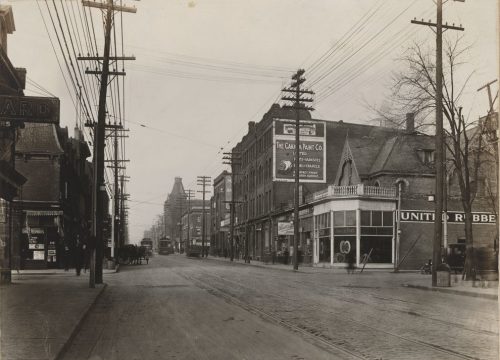
The cultural heritage value of the Historic Yonge Street Heritage Conservation District (HCD) is based on its historical significance as a major early transportation corridor that is often referred to as “Toronto’s Main Street”. Geographically, the District stretches from College Street to just south of Bloor Street and encompasses a 1 kilometre stretch of Yonge Street.
The District is valued for its commercial main street character, which is expressed, in part, by mixed-use and commercial buildings that housed the services, amenities, and employment opportunities to support daily life in neighbouring residential areas. An intact residential enclave in the District, St. Nicholas Village, helps to make this role legible today. It has social and community value related to its role as a place for congregation, rebellion and celebration throughout its history. In the twentieth century, these values were enhanced as the district evolved as a hub of entertainment venues including cinemas, theatres and dance studios. The Historic Yonge Street HCD has an intact collection of 19th century and early twentieth century commercial main street and residential type buildings that speak to its heritage values.
The Historic Yonge Street Heritage Conservation District Plan was approved by the Ontario Land Tribunal (OLT) in 2024.
The section of Yonge Street between College Street and Bloor Street has a dynamic history as one of Toronto’s premier main streets, occupied by independent businesses, government services, professional and fraternal organizations and cultural venues defined by late 19th and early 20th century commercial main street buildings.

The boundary limits run along property lines and include the full right-of-way of Yonge Street in front of any property within the boundary. The District’s northern boundary is the full right-of-way of Charles Street West on the west side of Yonge Street and the north lot line of the former Postal Station F at Charles Street East on the east side of Yonge Street. The centre line of Grosvenor Street on the west side of Yonge Street and Maitland Street on the east side of Yonge Street mark the southern boundary. Its western and eastern boundaries generally run parallel to Yonge Street along a historic network of service laneways, except along its western edge where it includes St. Nicholas Street and parts of St. Joseph Street and Irwin Avenue — an area referred to as St. Nicholas Village. The full right-of-way of public laneways have been included within the boundary, as has the full right-of-way of St. Nicholas Street.
In 2013, Heritage Planning, along with its consultant DIALOG, initiated an HCD Study for Historic Yonge Street. The Study, which was concluded in the summer of 2015, recommended that the area merited designation as an HCD on the basis of its historical, associative, physical, contextual, and social and community values.
City Council adopted the Historic Yonge Street Heritage Conservation District Plan in 2016. It was approved by the Ontario Land Tribunal (OLT) in June 2024.
Plan information, reports and publications will be listed below as they become available.
On July 28, 2015, the Toronto Preservation Board received a staff report and endorsed the HCD Study and its recommendations, including the revised boundary and the recommendation to proceed with the development of a Plan for the Historic Yonge Street HCD.
On March 10, 2016, City Council adopted item TE14.4, designating by by-law the Historic Yonge Street Heritage Conservation District, and adopting the Historic Yonge Street Heritage Conservation District Plan, dated January 2016, as the district plan for the Historic Yonge Street HCD.
On June 26, 2018, City Council adopted item TE33.21, authorizing staff to attend at the Local Planning and Appeal Tribunal (now the Ontario Land Tribunal) in respect of the appeals of the North Downtown Yonge Site and Area Specific Policy 382 (Official Plan Amendment 183) and the Historic Yonge Street Heritage Conservation District Plan, in support of the modifications to the Historic Yonge Street Heritage Conservation District Plan, as set out in the proposed policy harmonization strategy set out in the Confidential Attachment (now public). City Council also authorized some technical and stylistic changes as may be required to the Plan.
On May 10, 2023, City Council adopted item CC6.3, in support of proposed revisions to the policies in the Historic Yonge Street Heritage Conservation District Plan. The confidential attachments were made public on June 5, 2023.
A copy of the Historic Yonge Heritage Conservation District Plan is available from Heritage Planning upon request.
The Historic Yonge Street Heritage Conservation District was completed in accordance with Heritage Conservation Districts in Toronto: Policies, Procedures and Terms of Reference as adopted by City Council.
Section 3.1.5 of the City of Toronto’s Official Plan includes policies that direct the City to identify, protect and conserve heritage conservation districts within the City.
The Ministry of Tourism, Culture and Sport created the Guide to District Designation under the Ontario Heritage Act to inform the identification, study and implementation of heritage conservation districts in Ontario.
Part V of the Ontario Heritage Act allows municipalities to designate heritage conservation districts.